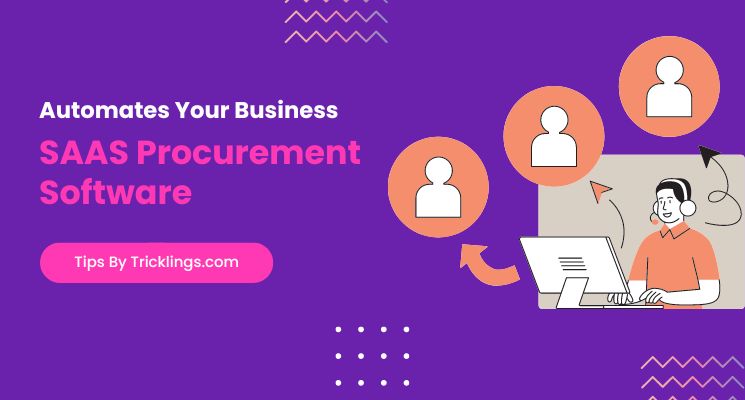Today business environment is changing rapidly, so it is important for the companies to have standardized procurement processes to become more competitive and efficient. An option that has been in use for years and also the one that has earned a lot of recognition is SaaS (Software as a Service) procurement software. These cloud-based business applications offer companies a vast array of advantages which can revolutionize traditional procurement practices. SaaS procurement program helps businesses of all sizes boost productivity and increase ease of operation, compliance, and teamwork. Moreover, it brings cost savings in terms of overhead expenses.
- Cost Savings
Adopting SaaS Procurement software is one of the key advantages due to the cost savings associated with it. Whatever hardware or infrastructure you need for traditional on-premises software solutions will not be needed in SaaS applications because of the nature of the Saas (software as a service) model. Thus, no need for tedious investments on parts and equipment for installation and maintenance arise.
Moreover, the software is usually sold on subscription, and this prevents businesses from spending on things they do not need because they only pay for the tools they are using. This system of payment on the basis of consumption guarantees the costs to be predictable as well as manageable, resulting in organizations not finding difficulties when it comes to budgeting or resource allocation.
- Increased Efficiency and Productivity
Procure-to-Pay process streamlined and automated including, but not limited to, generation of requisition orders, scope of agreement and vendor selection, negotiation of terms, good received, invoicing, and payment. The companies can achieve this by engaging software systems that can automate the repetitive tasks, for instance, creating and managing RFQ software (Request for Quotes), tracking orders, and processing invoices, thus, the teams will be allowed to concentrate on more strategic activities.
The software also enhances cooperation across various teams that might be coming from different departments by improving their communication and by giving them a platform for sharing data. That accounts for quicker decision-making, fewer mistakes, and shortened procurement cycles in total as compared to the idea of manual purchases. Consequently, businesses can be much more fast-paced and efficient in their strategies that allow them legitimately to react quickly when the markets are shifting.
- Improved Compliance and Risk Management
Procurement operations within this framework are a collection of different regulatory and authority rules. On the contrary, non-compliance with the standards can bring up a long legal chain of consequences. SaaS procurement tools are designed to solve this problem by being able to automatically actuate guardrails and approval workflows. They also guarantee that local purchasing regulations are complied with, thus decreasing the number of breaches and violations. In addition, the software has audit trail feature and reporting capabilities for clear audit records, allowing companies to show compliance to audits or lawsuits when necessary.
- Scalability and Flexibility
SaaS procurement software, being very scalable and flexible is one of the properties that make it an ideal choice for businesses. Businesses need to grow and their procurement requirements to be different from other requirements. The software, therefore, can automatically update to the new requirements without any modifications being necessary.
In the cloud-based operational model, it is possible to expand the number of new users or modules easily, without the requirement to carry out complex hardware upgrade or programming. To begin with, acquisition of SaaS procuring software often necessitates updates that the vendor rolls out on a regular basis. Therefore, users are guaranteed a seamless access to new features and security patches without the burdensome manual upgrade.
- Enhanced Supplier Management
If properly managed, the suppliers will contribute a lot to the success of the procurement activities. SaaS purchase system supplies tools and features that simplify of the workflows from supplier engagement and building better relations. Such as, software in this domain frequently has supplier portals that enable communication, a good collaboration and document sharing. As a result, it also makes it possible for enterprises to maintain detailed profiles of their suppliers, monitor performance, and score their suppliers by using the criteria decided beforehand. Such visibility into the performance of the supplier base of an organization gives it the ability to make rational decision while selecting and working with the suppliers through which it can ultimately achieve higher value for the money and reduce the level of risks in its supply chain.
- Mobility and Accessibility
Being in a mobile world today, purchasing officers most likely process reports and operate programs all while relocating. SaaS procurement software solves the problem of cloud computing mobility by providing mobile apps and interfaces, so the users can access the software even from devices without an internet connection. This high level of the demand for mobility ensures responsiveness and continuity with employees’ offices regardless of physical location.
- Integration with Other Systems
Mostly unlike the scenarios where discrete purchasing process interactions with other business process systems such as the enterprise resource planning (ERP), customer relationship management (CRM), and supply chain management (SCM) systems. These systems are able to interact with SaaS procurement software, which provides a real-time mechanism for data collection, ensuring a consistent picture of company data across the enterprise. Therefore, this integration eliminates the need for manual input of data and reconciliation, which consequently creates space for the reduction of occurring errors and helps to increase efficiency in the company.
Conclusion
The era of digital transformation has witnessed the SaaS procurement software driving not only the competitive edge, but becoming a must requirement in the business world. The use of this technology can be seen as a great tool that helps organizations improve their procurement giving them the advantages of streamlining their processes, lowering the costs, eliminating or reducing bottlenecks, and gaining valuable insights into their spending and supplier performance. Supporting for scalability, flexibility as well as the ability to integrate seamlessly with other systems, the SaaS software procurement is in a position of making businesses able to embrace the market changes and always ahead of the competition. With the growth of demand for the efficient and transparent procurement systems, regardless of the fact whether the organization is private or public, saas procurement software has become one of the key factors in making the organizations more effective in their operations and helping them move towards the prosperity path.









